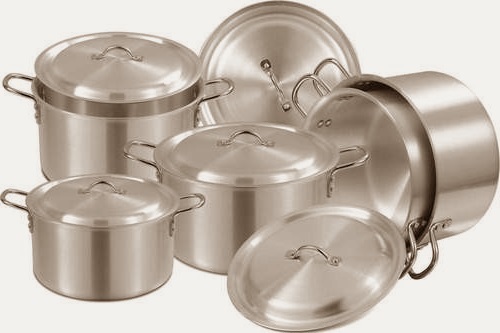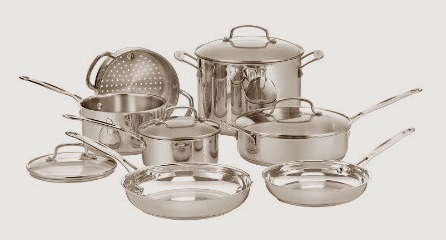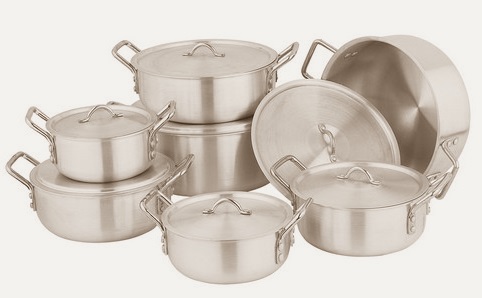
Why use Aluminum for Cookware?
Aluminum is not only low cost but also a great conductor of heat which makes it an ideal choice for cookware. Aluminum has a thermal conductivity that is 16 times that of stainless steel which why it will heat up quickly, evenly and 16 times faster than a stainless steel pot! But decades ago, as autopsy reports found unusually high levels of aluminum in the brains of people with Alzheimer’s disease, concern arose over the health risks of this metal, including the safety of cooking foods in aluminum cookware. The U.S. Food and Drug Administration (FDA) reports the amount of aluminum that leaches into food from this cookware is much less than the amount naturally present in foods and other consumer products. But because aluminum is a known toxin to the body, the safety of dietary aluminum and this cookware is still a controversial issue with consumers.
Aluminum Sources
Beyond cookware, aluminum is naturally found in rocks, minerals, clay and soil which is how it ends up in the plants we eat. It is also added to many processed foods. The Centers for Disease Control and Prevention (CDC) estimates the average adult consumes 7 to 9 mg of aluminum daily from foods, not including the amount that can leach into food by cooking with aluminum pots or pans. In addition, aluminum is added to many consumer goods, including some antacids, buffered aspirin, toothpaste, nasal spray and some cosmetics. As much as 100 to 200 mg aluminum is found in some antacid tablets, for example. In other words, it’s nearly impossible to avoid aluminum.
Leaching
Aluminum cookware may leach aluminum compounds into food. The person consuming this food then incorporates the aluminum into their body. Acidic foods cause more aluminum leaching than alkaline or pH neutral foods. However, the World Health Organization estimates that a person can consume 50 mg of aluminum per day without adverse health effects. According to Environment, Health and Safety Online, acidic tomatoes cooked in an aluminum pot collected only 3 to 5 mg of aluminum per serving. Anodizing of aluminum cookware creates a more formidable barrier to leaching. Aluminum cookware in good condition leaches less than that with scratches or pits.
Aluminum Poisoning
Aluminum cookware leaching high amounts of aluminum in combination with large amounts from other sources may cause poisoning. People in old age or with kidney problems experience heightened responses to aluminum poisoning. These responses include impaired mental functioning, anemia, muscle weakness and seizures. Doctors use various tests, such as a bone biopsy to confirm the body’s aluminum levels. Doctors treat aluminum poisoning with deferoxamine mesylate, which helps to remove excess aluminum from the body.
Alzheimer’s Disease
Consumer concern about the link between aluminum and Alzheimer’s disease in the 1980’s led to a Food and Drug Administration review of the risks of aluminum cookware. According to Michigan State University, the FDA concluded in 1986 that no information available proved harmful effects of aluminum intake from cookware and other typical daily sources. WebMD reports that while some researchers have found a correlation between high brain aluminum content and instance of Alzheimer’s, no one has reached conclusive evidence of causation. Moreover, exposure to large amounts of aluminum more likely results from antiperspirant, antacid and other medication use. The hazard that aluminum cookware poses pales in comparison to these other more potent sources of aluminum.
Minimizing your risk
- Do not cook or store food for long periods of time in aluminum cookware.
- Do not use badly scratched or un-coated copper cookware to cook or store food. If you do have some older tin or nickelcoated cookware, use it for decorative purposes only. Do not scour coated copper cookware.
- If you know you are allergic to nickel, do not use nickel-plated cookware.
- If you are sensitive to nickel and are having difficulty managing your allergy, discuss options with your doctor. Foods known to contain higher levels of nickel include oats and oat products, peas, beans, lentils and cocoa products, such as chocolate, particularly dark chocolate.
- Do not store foods that are highly acidic, such as stewed rhubarb or stewed tomatoes, in stainless steel containers.
- If you bring in glazed ceramic cookware from abroad, be aware that it may not meet Canadian permitted levels for lead and cadmium. Do not use it to serve or store food. Use it for decoration only.
- Don’t use plastic bowls or wrap in the microwave unless they are labelled as microwave safe.
- If you reuse plastic items for storage, such as dairy product containers, let the food cool before storing, then refrigerate it immediately. Avoid visibly damaged, stained or unpleasant smelling plastics and containers. Never heat or store food in plastic containers that were not intended for food.
- Do not use silicone cookware at temperatures above 220°C (428°F) as it will melt if exposed to high temperatures . You should also be careful when removing hot foods from flexible silicone cookware, as the food may slide out very quickly.
Stop Doing This With Aluminum Foil
What’s more, Dr. Zubaidy, one of the study authors, comments that: “The higher the temperature, the more the leaching. Foil is not suitable for cooking and is not suitable for using with vegetables like tomatoes, citrus juice or spices.”2 On the other hand, the researchers also noted that foil can be considered safe to wrap cold foods, since no leaching was observed without heating. They also did not find a difference if the shiny or dull side were in contact with food.
This happens because the presence of aluminum impedes calcium deposition in bone, thus leading to elevated blood calcium levels. As a result, PTH secretion, the hormone secreted by the parathyroid hormone, is greatly depressed. Additionally, chronic aluminum toxicity greatly reduces osteoblast population and inhibits bone mineralization, resulting in osteoporosis.
- Never cook, heat up, or place hot food on aluminum foil. Use foil only to store cold food in the refrigerator, or to wrap cold sandwiches. I use tempered glass pans. They are easily available in just about every supermarket or hardware store.
- Avoid storing tomatoes, citrus fruits, or spices in foil.
- Replace foil with wax paper if you wish to store food while still hot. Or use glass food storage containers. I keep a variety of sizes handy in my kitchen.
- Never use aluminum pots or cooking utensils. Instead, invest in stainless steel pots and pans.
Is Cooking With Galvanized Aluminum Healthy?
Galvanization is the process of coating a metal with zinc. This can protect the metal from deterioration, particularly when exposed to moisture and heat, such as in the case of aluminum cookware. However, this coating can react with heat and moisture, causing zinc to migrate into your foods as you prepare them. Damaged cookware, such as scratched or pitted pots and pans, can increase the migration of minerals into your food. This increased mineral content can have a negative impact on your family’s health.
Aluminum and Zinc
Both aluminum and zinc are necessary minerals for your health. However, in large doses, they have negative effects on your health. The National Institutes of Health place maximum zinc levels at 40mg per day for adults, and significantly lower for children, ranging from 34mg daily maximum for 14- to 18-year-olds down to 7mg for 1- to 3-year-olds. Health Canada reports that up to 50mg of daily aluminum intake has no ill effects on adult health, but has not made the same study for children. When cooking with galvanized aluminum, you have no way to tell how much of the zinc or aluminum have migrated into your food, so you cannot tell when or if toxic levels are reached.
Food Factors
Acidic foods increase the amount of zinc that moves from your cookware into your food. Most fruits are acidic enough to achieve this increase, whether they seem acidic, like lemons, or not, like apples. Tomatoes and tomato-based sauces are also highly acidic, and should never be cooked in galvanized aluminum pots or pans. If your galvanized coating is damaged, acidic foods also leach aluminum into your meals from the cookware.
Zinc Interactions
The negative effects of zinc, whether from galvanized cookware or other sources, can cause complications if you or anyone in your family is taking antibiotics, penicillamine or diuretic medications. Excessive zinc intake can reduce the effectiveness of these medications. Avoid using galvanized cookware altogether if anyone in your family is using these medications.
Alternatives
In general, the risks posed by galvanized aluminum cookware outweigh the benefits of its light weight and durability. This does not apply to all aluminum cookware, however. Anodized aluminum cookware features a nonstick coating that also reduces the migration of aluminum into your food, and it contains no zinc. Silicone, ceramics, enamel and glass are other alternatives, although you must make sure each is FDA-approved food-grade material.
Read more: Health Hazards of Aluminum Cookware
Aluminum Foil, Cooking , Health, Galvanized Aluminum, aluminium cookware, aluminum cookware, health hazard, food safety, tips, tricks





